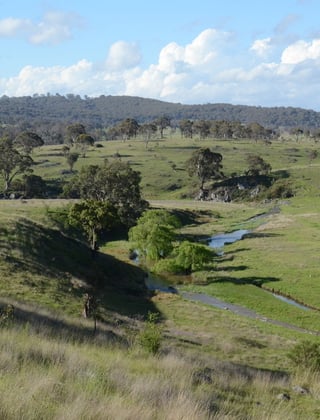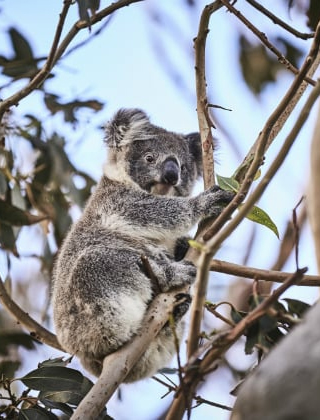Measuring outcomes of eco management
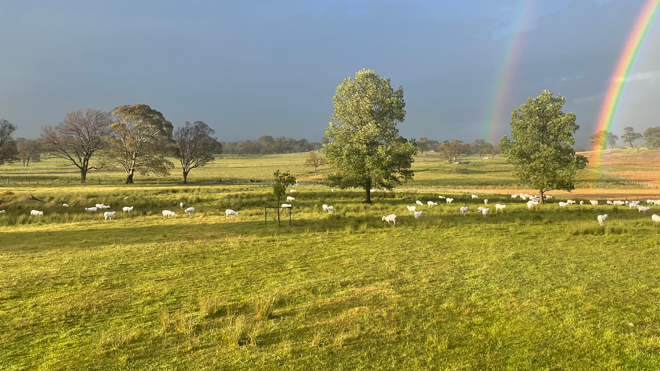
Jon and Claire Welsh, who farm on the Northern Tablelands of NSW, were two of the woolgrowers who provided input for the AWI-funded natural capital and environmental performance measures project. Here they outline the benefits they see with measuring and reporting their own farm’s natural capital.
“We want to improve our productivity and leave the farm in good shape, and give it the best possible prospects for success in business for the next generation.”
Woolgrowers Jon and Claire Welsh, Oban NSW
Jon and Claire Welsh own and run Square One Pastoral Co at Oban in the New England region of northern NSW. Their business is a mix of sheep and breeding cows; about 5,000 sheep DSE and 10,000 cattle DSE. The cows produce about 300 calves which the Welshes grow out to feeder steer weight (450 kg). The sheep are all Merinos growing ultrafine 15-16 micron wool.
The Welshes’ property comprises three separate land parcels, totalling 1250 hectares. Located on the Northern Tablelands at about 1300 metres above sea level, it receives a summer dominant rainfall averaging 900-1000 mm. Their pastures are based on a mix of fescue-based perennial, with some native pasture country and 50 hectares of old growth forest.
The Merinos are shorn every six to eight months and produce about 70 bales of wool per shearing.
“Our preference for selling our wool is to use forward contracts – this gives us confidence about our cash flows and simplifies our product marketing. We know that when forward contracts disappear there is less confidence from the supply chain. Typically, this means prices are softer and we then sell through the auction system in a more uncertain environment,” Jon said.
“Our wool is non-mulesed and sustainability certified via both the AWEX NM Wool Declaration and by Textile Exchange via the Responsible Wool Standard.
“We do find that there is effort involved in maintaining these certifications. It is our hope that Woolmark Nature Positive Farming specification will lead the way in building consistency and relevance around outcome-based measures.”
Jon and Claire Welsh were involved in AWI’s Natural capital and environmental performance measures for Australian woolgrowers project, which is building industry-wide consensus on the most commercially appropriate metrics for woolgrowers to measure, manage and report their on-farm natural capital and environmental performance (see this article in this edition of Beyond the Bale).
“We volunteered to be involved in the natural capital project woolgrower focus group because we wanted to help support a grower-led (bottom up) certification,” Jon said.
“We wanted to share the woolgrower reality about what’s practical. Anyone who has been through an audit would wonder who develops the questions and why some of the requested information is needed. The focus group gave us an opportunity to be heard and have an opportunity to influence the outcome.
“AWI has taken an industry view with this project and are focused on positive outcomes for the industry and growers. As an industry, we need to be on the front foot to demonstrate to customers that wool is an environmentally and ethically sound product. Participating in certification schemes helps to demonstrate this, although we think the design of schemes could be improved to give more confidence to the customer that we have a sustainable production system.”
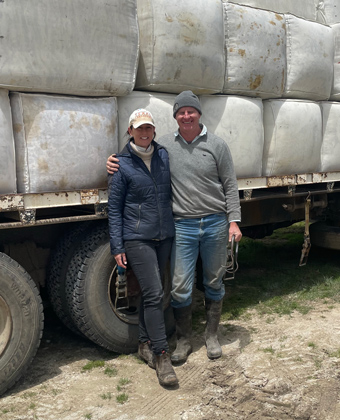
Claire and Jon Welsh with their wool clip.
Measuring the outcomes of management
Jon grew up on the farm and came home after finishing studies in economics and trade at the University of New England. Claire trained as an agronomist and crop physiologist / ag systems scientist at the University of Sydney.
“We understand the agronomic benefits of soil carbon, such as increasing water holding capacity and nutrient cycling, and believe the production benefits exceed the dollar benefits of carbon trading. A key business goal for us is to increase soil carbon and improve biodiversity over time,” Jon said.
For Jon and Claire, nature positive farming is how the family has been managing the land for generations.
“We don’t see ourselves doing much differently from other woolgrowers in our district. The only difference is now we’re measuring the outcomes of our management, and are more aware of the impact of our management,” Jon said.
“Our decisions are underpinned by a science focus, giving added rigour. We’re listening and adopting new practices to build soil carbon. For example, more watering points and fencing, pasture improvement using new fescues with novel endophytes, and the use of herbs such as chicory and plantain to potentially reduce ruminant methane emissions.
“We’re gearing our business up for a changing climate with more temperature and rainfall extremes.
“We hope one day measuring and managing biodiversity and carbon can diversify our income streams from the farm business. We hope nature positive farming gives us more market access and we’ve taken the view that one day it will, which is why we are measuring a whole bunch of new farm metrics.
“It gives us time series data from where we started, where we’re heading and how we’re tracking. It also gives us an understanding of the commercial reality of implementing management to improve carbon or biodiversity.
“One of our main achievements has been a focus on maintaining ground cover and proactive drought management strategies. We are conscious to de-stock quickly and rest our country to prevent it becoming bare, although this can be a challenge when livestock prices crash. Our livelihood depends on ground cover and healthy soils. In agriculture there are always curve balls – proactive management helps us to deal better with the uncertainties.”
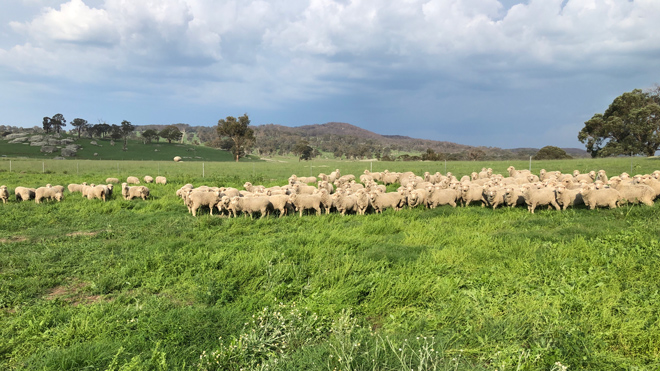
The Welshes’ ultrafine Merino flock on the Northern Tablelands of NSW.
Biodiversity Conservation Trust
The Welshes have a Biodiversity Conservation Trust (BCT) project with the NSW government, which they started working on in 2019 and registered in 2021.
“We haven’t yet sold any biodiversity credits, but it’s sitting there ready, with detailed baseline measures done. The decision to go down this path was made like we would any business decision, weighing up the costs and benefits.
“The business case for retaining and improving the old growth forest was a gamble but worth the risk with renewable energy projects eventually creating demand for credits.
“Going through the baseline measures opened our eyes to endangered flora and fauna values, for example peppermint gum, black cockatoo, greater glider, scarlet robin, healthland scrub.”
Taking action now to add value to your business
For the Welshes, nature positive farming and measuring natural capital is a no brainer.
“Integrity around nature positive farming is critical because markets are demanding environmentally-friendly wool. So the actions we’re taking now are not only helping our whole business be more resilient in a changing climate, but are also helping us adapt to regulatory and consumer changes,” Jon said.
“For woolgrowers who are sitting on the fence or peering over the fence wondering if this is for them or unsure of where to start, we would say start with measuring things like soil carbon or benchmarking carbon sinks and emissions. Remote sensing technology is coming online to be able to help with measuring above ground biomass and soil carbon.
“Read whatever you can and talk to woolgrowers who have already started on the journey. Whatever steps you take will add value to your business if you can use information from measuring to make informed decisions, as well as tell your story of positive environmental management.”
This article appeared in the September 2024 edition of AWI’s Beyond the Bale magazine. Reproduction of the article is encouraged.







